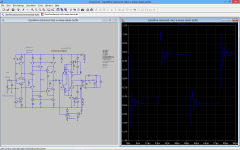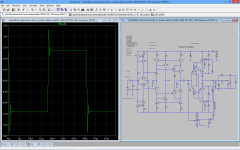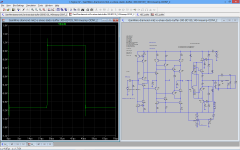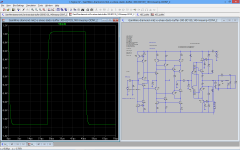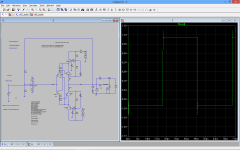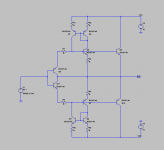I use the bob cordell method.
Ps: I can try to solve the problem... if you want, of course.
Ps: I can try to solve the problem... if you want, of course.
Last edited:
I use the bob cordell method.
You can't use Bob method here, it's not ordinary GNFB, use Thian probe or simple voltage probe as I used(good enough in this case). If you change resistors value or use inductor it will disrupt ODNF behavior.
the Thian Probe is a very good method.
I will have a closer look.
But at first look it seems similar to a classic GNFB , with the difference that the discrete circuit is doing the voltage swing , which facilitates the work of the opamp (less distortion), that only has to output the error voltage .
It seems a good technique for nested feedback loops.
But as I said , have to take a better look.
I will have a closer look.
But at first look it seems similar to a classic GNFB , with the difference that the discrete circuit is doing the voltage swing , which facilitates the work of the opamp (less distortion), that only has to output the error voltage .
It seems a good technique for nested feedback loops.
But as I said , have to take a better look.
This feedback method can have very low distortion, and I think that it can be use in a class B power amplifier with good results.
Is this protected by a patent? who invented?
but this circuit have some points that needs to be improved.
the settling time of the circuit is very bad .
Is this protected by a patent? who invented?
but this circuit have some points that needs to be improved.
the settling time of the circuit is very bad .
Attachments
Why it would be -12V, it will be just enough to set output DC close to zero.
Why? There is no feedback from output to that point.
This feedback method can have very low distortion, and I think that it can be use in a class B power amplifier with good results.
Is this protected by a patent? who invented?
but this circuit have some points that needs to be improved.
the settling time of the circuit is very bad .
Thanks for the simulation, probably it needs input lowpass filter.
Sorry, highpass filter!
Last edited:
Why? There is no feedback from output to that point.
Yes there it is, ODNF op amp. Try to simulate.
In post #125 the simulation was made with a lt1007.
here is with the original lme49710. First picture with the ODNF, second with the normal feedback.
the resistor P1 (10k) is slowing the feedback action.
third picture is without global negative feedback.
here is with the original lme49710. First picture with the ODNF, second with the normal feedback.
the resistor P1 (10k) is slowing the feedback action.
third picture is without global negative feedback.
Attachments
In post #125 the simulation was made with a lt1007.
here is with the original lme49710. First picture with the ODNF, second with the normal feedback.
the resistor P1 (10k) is slowing the feedback action.
third picture is without global negative feedback.
What are you talking abouth here, what normal feedback??
In second case this is not any more my pre amp, you disconnected the gain block completely and op amp acts as the gain stage, please don't do that!!!
I am not sure you understood the main concept here.
what I am trying to say, is that your feedback loop is to slow.
And you can call it whatever you want, but this is a global feedback loop.
I like your original concept , and I am sorry you change it.
If you want I can help with the buffer, if you decide to ignore my advice is also ok 🙂
And you can call it whatever you want, but this is a global feedback loop.
I like your original concept , and I am sorry you change it.
If you want I can help with the buffer, if you decide to ignore my advice is also ok 🙂
what I am trying to say, is that your feedback loop is to slow.
And you can call it whatever you want, but this is a global feedback loop.
I like your original concept , and I am sorry you change it.
If you want I can help with the buffer, if you decide to ignore my advice is also ok 🙂
No it's OK, I like your help, just second simulation does not have any connection with my GaiWire. If you don't like ODNF concept then just don't use it. This pre amp is good enough without it and I did not change it. Only problem is DC offset at the output and I am not sure yet how to eliminate it without DC servo or ODNF. The PCB can be used both ways.
I never used ODNF in a real amp and I am curious how it sound, but first I have to build the prototype.
there is a group buy for the calvin buffer , Calvin is a very talented designer , and his buffer seems perfect for your application.
I am also doing a buffer for my headphones , but I have a lot of projects going on right now , so it is on hold .
http://www.diyaudio.com/forums/group-buys/239776-calvin-buffer-paradise.html
I am also doing a buffer for my headphones , but I have a lot of projects going on right now , so it is on hold .
http://www.diyaudio.com/forums/group-buys/239776-calvin-buffer-paradise.html
just second simulation does not have any connection with my GainWire.
the second simulation was just to show the settling time with only the opamp , I have redesign the circuit to better understanding.
Ok... now Forget this 🙂
Attachments
If you don't like ODNF concept then just don't use it. This pre amp is good enough without it and I did not change it. Only problem is DC offset at the output and I am not sure yet how to eliminate it without DC servo or ODNF. The PCB can be used both ways.
I never used ODNF in a real amp and I am curious how it sound, but first I have to build the prototype.
If you do not want to use capacitors at the output, is mandatory to use dc servo ofcourse.
And you are right, the dcservo and the ODNF are so similar, that you can design the PCB board to use one option or onother.
One thing that may improve the settling time is using a small capacitor in parallel with the resistor (P1), but you have to test it.
One way or another, I like the concept, I think you are doing a good job, I wish I had more time to help you more, but yesterday I receive a buffalo dac , and I am curious to see how it stands against my PCM1794 🙂
there is a group buy for the calvin buffer , Calvin is a very talented designer , and his buffer seems perfect for your application.
I am also doing a buffer for my headphones , but I have a lot of projects going on right now , so it is on hold .
http://www.diyaudio.com/forums/group-buys/239776-calvin-buffer-paradise.html
I know about Calvin buffer. What's wrong with my buffer? I wanted to use BJTs only here in this pre amp as I made the one with JFETs http://www.diyaudio.com/forums/anal...onveyor-voltage-amplifier-24.html#post3447084 and FETs are not easy to find any more.
There is nothing wrong with your buffer ,your buffer is perfect for line_out.
But if you want to drive low impedance loads like some headphones , the Calvin buffer that uses local feedback is more apropriate.
But for line_out I would prefer your buffer.
But if you want to drive low impedance loads like some headphones , the Calvin buffer that uses local feedback is more apropriate.
But for line_out I would prefer your buffer.
There is nothing wrong with your buffer ,your buffer is perfect for line_out.
But if you want to drive low impedance loads like some headphones , the Calvin buffer that uses local feedback is more apropriate.
But for line_out I would prefer your buffer.
As I understood Calvin buffer is single ended and mine is pushpool, and I thig more suited for low impedance load.
I use buffers exactly like yours , and I know that with low impedance the distortion rises.
The Calvin buffer was tested with low load impedances by Joachim Gerhard, the output current can be limitating.
The amplifier that I use with my headphones (250 ohms) have also single ended output with 50ma d.c.
The Calvin buffer was tested with low load impedances by Joachim Gerhard, the output current can be limitating.
The amplifier that I use with my headphones (250 ohms) have also single ended output with 50ma d.c.
- Status
- Not open for further replies.
- Home
- Amplifiers
- Solid State
- No NFB line amp (GainWire mk2)
